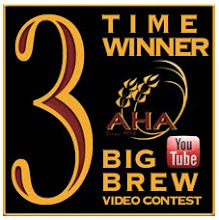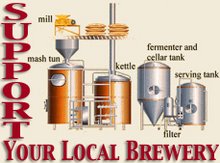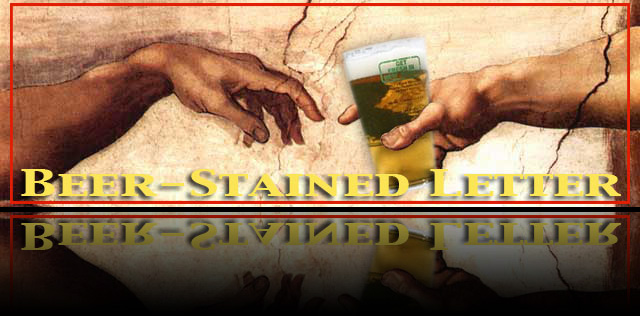A beer book built around flavors
 Three years ago, during an interview with the US Beer Drinking Team at a Beer Institute gathering, Boston Beer's Jim Koch was asked what beer he'd drink if his Samuel Adams brand were unavailable to him. Deflecting the question, Koch said, "I'll remember what my (brewmaster) dad said, 'Jim, all beer is good. Some beer is better, but all beer is good.' "
Three years ago, during an interview with the US Beer Drinking Team at a Beer Institute gathering, Boston Beer's Jim Koch was asked what beer he'd drink if his Samuel Adams brand were unavailable to him. Deflecting the question, Koch said, "I'll remember what my (brewmaster) dad said, 'Jim, all beer is good. Some beer is better, but all beer is good.' "
Craft beer writer Andy Crouch of BeerScribe – he's also a BeerAdvocate columnist and a Boston-area lawyer – doesn't necessarily share his fellow New Englander's take on beer as a whole.
"I don't know that all beer is necessarily good," he says during a telephone interview. But Crouch, whose new book, Great American Craft Beer (Running Press), hit the shelves in August, says there is some really great beer being made in nearly every state of the US these days, in practically every compass point. A much wider reach than its predecessor, The Good Beer Guide to New England (2006, University Press of New England), Crouch's latest book navigates the American brewing landscape in more than 300 beer profiles that will surely tempt readers to reach for a brew along the way.
And for those keeping score, among the 200 or so breweries spotlighted in Great American Craft Beer, New Jersey's Flying Fish (and its 2008 GABF silver medal-winning Abbey Dubbel) and High Point Brewing (Ramstein Classic and eisbock) get mention among the profiles and style notes.
Andy took some time last week for a Q&A, discussing how the US has become a brewing nation like never before and reminding us that some beers can be appreciated for their fewer – not more – ingredients. BSL: Why did you write this book?
BSL: Why did you write this book?
AC: I'd written a previous book called The Good Beer Guide to New England. That was a travel guide to the region in which I live. And then I wanted to write Great American Craft Beer, I wanted to try and broaden the audience for American craft beer, break beer down, not so much by style and incredibly geeky detail, but do it in a way that was much more approachable for people, build a book around flavor, flavors that people are already familiar with. I think we got to do that with this book. I'm hoping the public agrees and enjoys it as well.
BSL: This may seem like a silly question, but you actually did taste every single beer that's profiled in the book ...
AC: The book is based upon beers that I have tasted over the past 10 years or so. I've been writing about craft beer for 10 years, so I'm very familiar with all of these brands and have tasted them a number of times over the years, and more recently talked to some brewers about some beers that had a particularly good reputation that I had not tried yet. So that's where the reviews in the book come from.
BSL: How many beers are actually noted in the book?
AC: There are about 350 beers that are covered and profiled in the book.
BSL: From how many breweries?
AC: That is a good question. I don't actually know the full answer to that. But I would guess the number is somewhere around 200. There are beers from almost every single state. I think there's one or two states that might not be listed. We tried to get a good cross-section of everything across the country.
BSL: The question then becomes, where in the United States is there no beer?
AC: There are certain states that have taken longer than others to come along. There are some southern states for which craft brewing is still not particularly well represented. There are some states like South and North Dakota that are fairly limited. North Dakota might be another state that doesn't have an entry. They frankly just don't have a lot of brewing going on there. Certainly there are going to be some places that are underrepresented ...
BSL: As far as the United States goes, are we the global stage for beer nowadays?
AC: Yeah, I think that really has become the case. The US right now is really quite a leader in brewing in a way it really hasn't been perhaps ever in its history. Right now, some of the most exciting things happening in the world of beer are indeed happening here in the United States. We have probably the widest breadth of styles and different kinds of beer of every conceivable style, including many that have never existed before, and have some world-class brewers who really are on par with some of the greatest brewers that the classic brewing nations have to offer.
BSL: Craft beer drinkers like to seek holy grails. They like beers that are sort of touchstones; they like to go to them. So do you envision this book as sort of a travel companion?
AC: I think it can be. But in this day and age I don't know that people have to particularly travel too far in a lot of parts of the country for great beer. Great beer seems to be more and more coming to them.
BSL: Beer is a way of traveling to places without actually having to go to them. Certain styles represent certain geographic regions of the country and the world. That's more true now than ever, right?
AC: I think so. Beer and brewing is really about place. While I think it can be done, I don't think sort of armchair drinking is the way to go. As brewers start to move around the country with their distribution into new markets, certainly the book can work as a guide for individuals who want to learn more about particular styles or particular breweries. But I also recommend that people get out and visit these breweries as well because the beer tastes best when it's tasted fresh. And I also don't think beer can be fully divorced from the surroundings in which it comes from.
BSL: Doesn't it say something about beer's place now at the table that you're defying convention, so to speak, by explaining beer to people, the complexity, parsing the flavors? Because the notion that beer is bubbly, slightly bitter and supposed to be yellow (in color) ... That's still ingrained in a lot of people's viewpoint.
AC: Well, the big brewers spent a lot of money over decades drilling into people's minds that beer was not about flavor, was not about the differences in the products themselves, and they sort of became these very much interchangeable widgets. If you were at a bar and a particular beer kicked, and the pub owner didn't have any more of that particular brand, he wouldn't bother to change the (tap) handle. They would just throw on whatever else they had and nobody was the wiser. Nowadays, you really can't do that. People are getting around to trying all these different beers and beginning to realize flavor is where it's at. I think it's time we start talking about (it) in that way, even though for a good portion of the population this is going to be something new to them. So I think the book tries to approach this, not just from a beer geek perspective – though I think there's plenty in the book to satisfy that audience as well – but also just to introduce and try to broaden the audience for craft beer.
BSL: Do you think Budweiser is a dying brand?
AC: There's always going to be a place for the macro brands. They obviously have an economy of scale; they are humongous producers, so they have a lot of clout in the distribution system and obviously in marketing, so I think they'll be around for a long time. I don't think we're going to see them go away. But I think brands such as Budweiser – it's having its own trouble ... been on decline for the better part of a decade. You know there's been the new campaign recently that they're going to try to give away Budweiser free on a particular day. You know that is a tough gig for the folks at Anheuser-Busch InBev. But with that said, light beer continues to sell particularly well, so I think those light beer brands are going to be around for a long time. (But) even the big breweries realize, that while they may not be losing a whole ton of market share to craft beer, they are losing dollars to craft beer, and they're beginning to play a lot more, much more, in the craft beer market, and I expect we're going to see a lot more of that in the years to come.
BSL: You profile two New Jersey beers in the book, Flying Fish Dubbel and High Point's Ramstein Classic. With Ramstein Classic, you refer to dunkelweizen as a little understood category. Why do you think dunkelweizen is that way?
AC: I think German styles overall tend to be a little bit misunderstood, and dunkelweizens in particular. They mix two styles that aren't really that well understood by consumers. With the advent of Blue Moon by Coors, they're beginning to understand sort of cloudy, yeastier beer, such as Belgian-style wit beer, and German-style hefeweizen a little bit more. But dunkel is something they never really understand, so when you mash these two together ... I would say even in Germany when I travel there, this is not a style necessarily particularly well understood. I think it's one of those ones where you mix some sort of caramel malt flavors with some toasted flavors, with some unusual banana and clove notes, it's kind of an odd drinking experience. But I think it's one that's pretty wonderful and pretty interesting across the board. But I think the public generally doesn't quite know what to do with these beers sometimes.
BSL: With extreme beers, the super-hopped and higher alcohol, do you think they are starting to play themselves out, are people coming back around to something that's a reliable beer, one they can always have in their glass and be comfortable with?
AC: I think that has played itself out to some extent. As to how far, it's sort of hard to say. I think that people are beginning to come back around a little bit to wanting a flavor experience they can revisit with some frequency. A lot of the times, these big beers, as you noted earlier, tend to be sort of holy grail beers where people seek them out and move on to the next conquest. It was a very interesting experiment. I'm glad that we went through it and got to experience it. But nowadays, I think, people are hopefully coming back a little bit more to their senses and wanting some more everyday, drinkable, approachable beers. Whether that's with lagers or session beer or ones with simpler numbers of ingredients, I think it's hard to say. As I said in the book, just because your beer is simpler in ingredients doesn't mean that it doesn't have complexity and character in its own right. Some brewers can do fantastic things with a single hop variety, or one or two malt varieties, as opposed to having to always put in 18 different kinds of hops, eight different kinds of malts and fermented in barrels with four yeast strains. Sometimes simple is better, and it certainly can be as characterful as some of the crazy complex offerings we've enjoyed over the last few years.














No comments:
Post a Comment